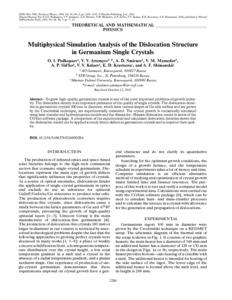Multiphysical simulation analysis of the dislocation structure in germanium single crystals
Скачать файл:
URI (для ссылок/цитирований):
https://elib.sfu-kras.ru/handle/2311/33067Автор:
Podkopaev O.I
Artemyev, V. V.
Smirnov, A. D.
Mamedov, V. M.
Sid’Ko, A. P.
Kalaev, V. V.
Kravtsova, E. D.
Shimanskii, A. F.
Коллективный автор:
Институт цветных металлов и материаловедения
Кафедра композиционных материалов и физико-химии металлургических процессов
Дата:
2016-09Журнал:
Technical PhysicsКвартиль журнала в Scopus:
Q3Квартиль журнала в Web of Science:
Q4Библиографическое описание:
Podkopaev O.I. Multiphysical simulation analysis of the dislocation structure in germanium single crystals [Текст] / Podkopaev O.I, V. V. Artemyev, A. D. Smirnov, V. M. Mamedov, A. P. Sid’Ko, V. V. Kalaev, E. D. Kravtsova, A. F. Shimanskii // Technical Physics: Theoretical and mathematical physics. — 2016. — Т. 61 (№ 9). — С. 1286-1291Текст статьи не публикуется в открытом доступе в соответствии с политикой журнала.
Аннотация:
To grow high-quality germanium crystals is one of the most important problems of growth industry. The dislocation density is an important parameter of the quality of single crystals. The dislocation densities in germanium crystals 100 mm in diameter, which have various shapes of the side surface and are grown by the Czochralski technique, are experimentally measured. The crystal growth is numerically simulated using heat-transfer and hydrodynamics models and the Alexander–Haasen dislocation model in terms of the CGSim software package. A comparison of the experimental and calculated dislocation densities shows that the dislocation model can be applied to study lattice defects in germanium crystals and to improve their quality.

